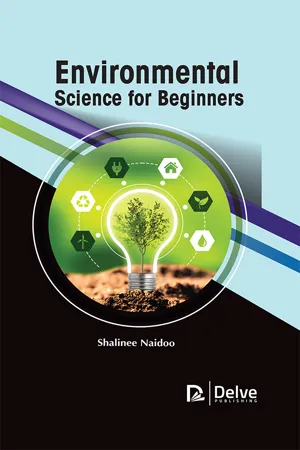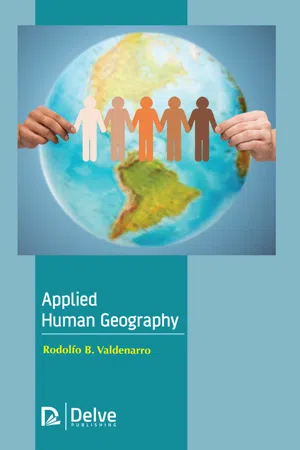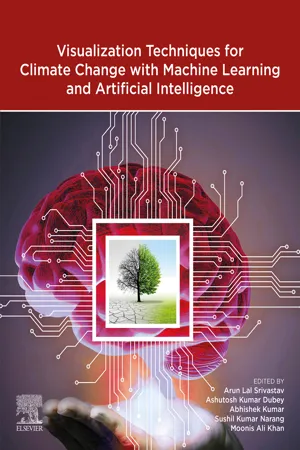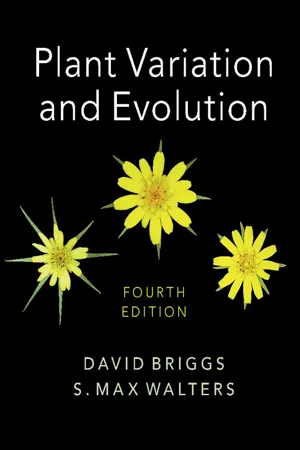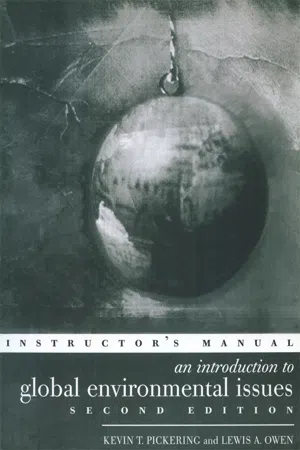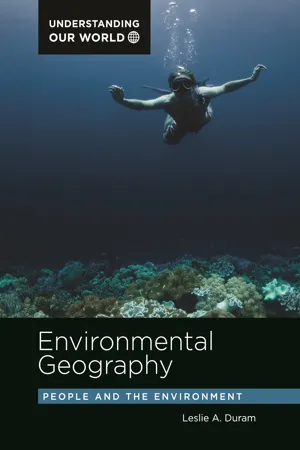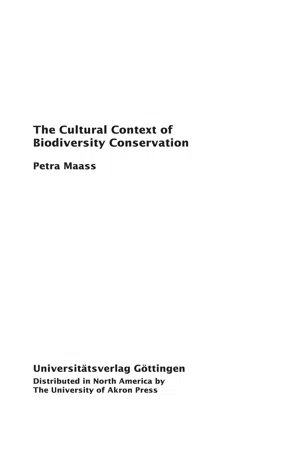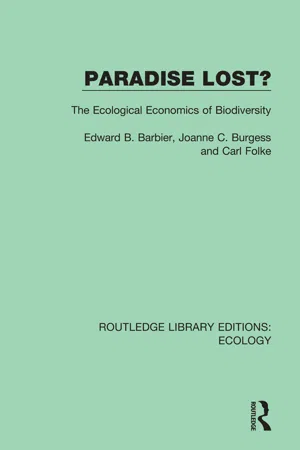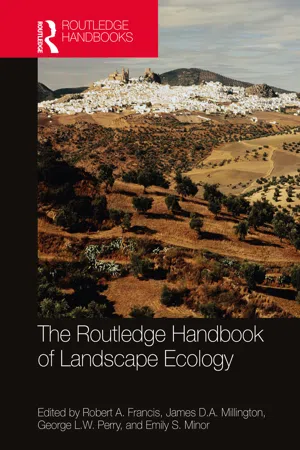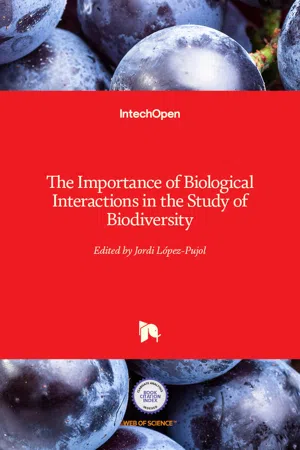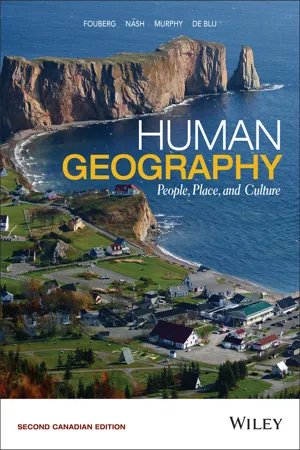Geography
Human Impact on Biodiversity
Human impact on biodiversity refers to the negative effects of human activities on the variety and abundance of living organisms in a given area. This includes habitat destruction, pollution, overexploitation of natural resources, and the introduction of invasive species. These activities can lead to a loss of biodiversity, disrupting ecosystems and threatening the balance of natural systems.
Written by Perlego with AI-assistance
Related key terms
1 of 5
12 Key excerpts on "Human Impact on Biodiversity"
- eBook - PDF
- Shalinee Naidoo(Author)
- 2023(Publication Date)
- Delve Publishing(Publisher)
Despite the benefits of such global objectives, biodiversity still continues to be lost at an alarming rate worldwide which has ultimately resulted in the degradation of the environment (OECD, 2014). This loss of biodiversity and consequently related environmental degradation are often the results of factors outside the control of environmental groups and leaders. Thus proper examination between biodiversity and various related links with climate change, water, agriculture and fisheries together with ensuring policy coherence at both, national and international levels is essential. THE HISTORY OF BIODIVERSITY Human impacts have increased dramatically in recent times which in turn have had an intense effect on surrounding habitats leading to the destruction of ecosystems as well as loss of species which consequently has led to a loss in biodiversity. Over the last few millennia, human impacts have had a major influence on the ecological diversity of the Earth, either directly by affecting Environmental Science for Beginners 222 wildlife and surrounding vegetation or indirectly by influencing a host of environmental resources. Humans depend on the biodiversity found on Earth for survival. It began thousands of years ago when the Earth first formed. Our ancestors roamed the Earth as hunters and gatherers, interacting with the environment in various ways for survival. As time passed and as mankind progressed, so did their knowledge of farming and the environment. This allowed them to manipulate their surroundings in order to grow food and build homes. Hunting animals for food was common practice while some were used for breeding and others for working on the farms. In addition to the animals, various plants varieties were harvested while others were discarded. The famous Greek philosopher, Aristotle is known for his early attempts to document and classify biodiversity. - eBook - PDF
- Rodolfo B. Valdenarro(Author)
- 2019(Publication Date)
- Delve Publishing(Publisher)
The Impact of Human on Environmental Geographies 10 CONTENTS 10.1. Introduction .................................................................................. 204 10.1. Environmentalism ......................................................................... 207 10.2. Nature Of Environmental Geography ............................................ 209 10.3. Human-Environment Relationships In Modern And Postmodern Geography ................................................................ 212 10.4. The Nature–Society Dichotomy ..................................................... 218 10.5. Geographic Information Systems And Environmental Health ........ 220 Applied Human Geography 204 Rampant industrialization and advancements in technology has caused significant threats to the environment. Environmental geography is concerned with the spatial aspects of interactions between humans and the natural world. The chapter begins with a discussion of environmentalism. It then describes the various aspects of environmental geography. The impact of humans on environment can be traced to the day when the first man arrived. This chapter discusses how humans and environment is linked in the modern day. The chapter also highlights how there is strong divide between nature and society. Finally, the chapter discusses geographic information system and environmental health. 10.1. INTRODUCTION Geography is the field of science devoted to the study of the lands, features, inhabitants, and phenomena of the Earth and planets. The word geography is derived from the Greek word geographia , which means “earth description” The field of geography encompasses multiple disciplines to understand the Earth and its human and natural complexities. - eBook - ePub
- Ashutosh Kumar Dubey, Abhishek Kumar, Sushil Kumar Narang, Moonis Ali Khan, Arun Lal Srivastav(Authors)
- 2022(Publication Date)
- Elsevier(Publisher)
Basically, all these factors are determined by the anthropogenic activities and natural factors which have increased in the last decade because of increasing population and demand of the economy (Vitouesk et al., 1997). Therefore, man is tagged as the principal cause of a change in the planet by releasing carbon dioxide from industrial processes and breakdown of the ozone layer by the production of chlorofluorocarbons (Redford, 1995). This has led to threat on terrestrial and aquatic ecosystems, enhanced survival of some while also causing the extinction of others. The major cause of biodiversity loss is agriculture intensification and the goods and services derived from biodiversity are: • Soil biodiversity • Pollination • Nutrient cycling • Biological control (Foley et al. 2009) 7.5.3.1 Impacts of human on biodiversity The potential impacts of humans on biodiversity are as follows: • Nitrogen deposition • Land degradation • Species exploitation • Pollution • Water diversification • Invasive or alien species introduction • Urbanization • Industrialization • Landscape fragmentation (Penuelas et al., 2020 ; Rutten et al., 2014 ; Pilling et al., 2020 ; Branca et al., 2013 ; Webb et al., 2018) 7.5.3.2 Threats to biodiversity The most pressing issue is the interaction between climate change and the threats to biota. Among all, pollution, invasive species, habitat fragmentation, and over exploitation are some of the direct threats to biodiversity (Eldredge, 2002) - eBook - PDF
- David Briggs, S. Max Walters(Authors)
- 2016(Publication Date)
- Cambridge University Press(Publisher)
When humankind lived as hunter- gatherers, their impact on the world’s ecosystems was probably small, but now, with burgeoning populations, almost everywhere across the world has been influenced to a greater or lesser extent by human activities. Now, perhaps, ‘2/3 of the world’s terrestrial land has been modified for human use’ (Mace & Purvis, 2008). Despite the uncertainties about the number of species currently endangered, evidence supports the view that we are in the midst of a biodiversity crisis (see Wilson, 1985; Barnosky et al., 2012), although there are often considerable difficulties in establishing whether any particular species has finally become extinct (see Collen, Purvis & Mace, 2010). In an unprecedented stocktaking of UK wildlife, compiled by 25 conservation groups, very serious declines in many species were revealed (State of Nature Report, 2013; see www.rspb.org.uk/Images/stateofnature). And, as we have seen, biodiversity loss is being driven by many interacting factors, some of which were recognised in Rachel Carson’s exposé, in her famous book Silent Spring (1962), of the effects of indiscriminate use of pesticides. However, as we have seen in this chapter, in addition to the many long-recognised threats to biodiversity, we now have to acknowledge the dramatic impact of accelerating climate change. Plant species whose ecosystems are subject to significant adverse climate change may not be able to adapt or disperse to ecologically appropriate new areas. Reaching the limits of phenotypic responses and biochemical adjustment, species may lack the genetic potential to adapt to changing conditions. Species may have very limited potential to migrate in tandem with the changing climatic conditions. The timeframe for possible response may not match the extended life cycle found in many species. - eBook - ePub
Ecosystem and Territorial Resilience
A Geoprospective Approach
- Emmanuel Garbolino, Christine Voiron-Canicio(Authors)
- 2020(Publication Date)
- Elsevier(Publisher)
The landscape transformation of the concerned territory has ecological implications that must be evaluated. We consider that the changes may cause the biodiversity affectation because of the landscape fragmentation in the interior of the territory. This is why it is necessary to evaluate the alternative policies for territorial and biodiversity governance that enable the control of the urban expansion and dispersion as a measure of sustainable urban planning.The next part is dedicated to the presentation of the methodology we used in order to characterize the biodiversity levels of the studied territory.5.4 Model of territorial biodiversity
In order to assess the potential impacts of landscape transformation and climate change on the biodiversity of the Alpes-Maritimes, we developed a model of biodiversity based on landscape ecology. The first part is related to the definition of biodiversity we used in order to formalize our model. Then, we present the methodology to assess the biodiversity level of the studied territory.5.4.1 What do we intend by “biodiversity”?
The term “biodiversity” is a contraction of the term “Biological diversity”. It was proposed in 1985 by W. Rosen then taken up in 1988 by E. Wilson et al. in the book entitled “Biodiversity” (Wilson and Peter, 1988 ). Article 2 of the Convention of Biological Diversity edited by the United Nations Environment Programme (UNEP) on May, the 22nd of 1992, defines the “Biological diversity” as “the variability among living organisms from all sources including, inter alia, terrestrial, marine and other aquatic ecosystems and the ecological complexes of which they are part: this includes diversity within species, between species and of ecosystems.” This definition can be considered as the official definition of biodiversity that integrates the notion of variability of the expression of life over the world in the different ecosystems.According to Magurran (1988) - Lewis A. Owen, Professor Kevin T Pickering, Kevin T. Pickering(Authors)
- 2018(Publication Date)
- Routledge(Publisher)
CHAPTER 9 Human impact on the Earth's surface Aims • To examine the main environments on the Earth's surface and the processes that operate within them. • To assess the impact of human activity on the Earth's natural environments throughout time. • To evaluate the environmental impact of human activity and methods to reduce the impact. Key point summary • Rapid population growth has resulted in increased demands upon the Earth's resources, which has led to accelerated environmental degradation, and precipitated potentially serious global climate change. • The human impact on land has been enormous. As land use changes, natural vegetation is cleared for agricultural use, settlements and urbanisation increase, reservoirs are created, minerals are extracted, and more land is developed for recre-ation purposes. • Acute concern is now widely expressed over the deforestation of boreal and tropical forests, the degradation of grasslands and wetlands, and desertification. Such destruction of natural ecosystems leads to a reduction in biodiversity and impoverishment of soils. • Attempts to counter the deleterious effects of land misuse in some areas include the introduction of exotic plants and animals, and the monitoring of indigenous fauna and flora. • Human impact on soils has caused considerable damage. This is commonly because of poor agricultural practices, excessive water extraction, poor irrigation methods (for example, leading to salinisation), defoliation (particularly resulting in laterisation), and compaction by heavy vehicles and animals. The cumulative effects of these can be disastrous for countries whose economies are heavily dependent on agriculture. • The amelioration of these poor land-use practices and improved soil quality require an understanding of the chemistry of soils and nutrient supply cycles. • Wetlands contribute almost a quarter of the world's primary productivity and are essentially the interface between terrestrial and aquatic envi-ronments.- eBook - ePub
Environmental Geography
People and the Environment
- Leslie A. Duram(Author)
- 2018(Publication Date)
- ABC-CLIO(Publisher)
There are numerous benefits from biodiversity, including those related to health, economics, and sustainability. Many medical discoveries that have helped cure diseases were based on genetic research of plants and animals. Diversity of pollinators, plants, and soils is the basis of the human food supply. Biodiversity makes Earth livable for people: ecosystems work to clean our water, absorb chemicals, and decrease the effects of flooding. Plants make the oxygen people breathe!Biodiversity is now threatened like never before in human history. The main threats to biodiversity are human population growth, urban sprawl, pollution, climate change, and overexploitation of species. Human population growth decreases biodiversity as people destroy natural habitats for more cropland and grazing lands. Urban sprawl is the process whereby cities extend ever farther into the countryside, replacing natural habitats with roads and concrete. Human activities have drastically changed the landscape; for example, an estimated 80% of the original forest that covered the Earth 8,000 years ago has been cleared. Pollution affects animal and plant health, as well as human health, so environmental disasters can have negative effects on biodiversity. Climate change is changing native habitats and could affect up to half the world’s species by 2050 (EU, 2004). Globally, overexploitation is decreasing biodiversity. In Europe, 80% of fish species are facing extinction or collapse due to overfishing (EU, 2004). And in North America, birds have declined 61% between 1966 and 2014 due to land-use changes and destruction of habitat (NWF, 2018).See also: Section 1: Biodiversity Loss , Deforestation , Overfishing ; Section 3: Case Study 13FURTHER READINGAustralian Museum. 2018. “What Is Biodiversity?” https://australianmuseum.net.au/what-is-biodiversity .EU. 2004. “Biodiversity Loss: Facts and Figures.” European Union. February 9. http://europa.eu/rapid/press-release_MEMO-04-27_en.htm .IUCN. 2018. International Union for Conservation of Nature. www.iucn.org .NWF. 2018. “What Is Biodiversity?” National Wildlife Federation. https://www.nwf.org/Wildlife/Wildlife-Conservation/Biodiversity.aspx - eBook - ePub
The Cultural Context of Biodiversity Conservation
Seen and Unseen Dimensions of Indigenous Knowledge among Q'eqchi' Communities in Guatemala
- Petra Maass(Author)
- 2010(Publication Date)
- University of Akron Press(Publisher)
The core idea [...] is that the existence and the future course of biodiversity is dependent upon both biological and socio-cultural processes. [...] it is essential to see biodiversity in its multilevel process of conditions and impacts.(Kamppinen & Walls 1999: 14f.)As the highest densities of natural diversity occur in tropical forests, so called biodiversity ›hotspots‹ are found almost exclusively in marginal areas of developing countries in what used to be called the ›Third World‹. The great majority of these ›hotspots‹ are located in areas inhabited by indigenous and/or bordering farming communities (Christie & Mooney 2000: 321).10 Access to these centres located at the peripheries of the global ›South‹ by the more industrialised ›North‹ has been conventionally justified by the »common human heritage« argument, which posits that biological resources are the legacy of all humankind. Such views, as argued here by Nazarea (1998: 115f.), are based on the notion that biodiversity, though being a product of evolution, reflects the combined influence of specific physical environments and human impacts. Flora and fauna make up not only the natural but also the cultural characteristics of a region in the way that they are used and domesticated over centuries or millennia. This line of reasoning suggests the widely acknowledged fact that »the concentration of biodiversity at the periphery of the global system is not accidental« (Dove 1996: 47). In particular, the significant spatial correlation of regions characterised by high levels of biodiversity and territories inhabited by indigenous communities are argued to be evidence of a close interdependency of natural resources and human ecology. In this respect, the role of indigenous cultures is widely discussed in the literature on biodiversity protection because of the different relationship that small-scale societies are said to have developed with the environment.Before going further into the analysis of connections between biodiversity and human resource use patterns, the term ›indigenous‹ should be taken into consideration. Put simply, the term denotes »anything produced, growing, or living naturally in a particular region or environment« (Grim 2001: xxxvii). Yet, it is a highly contentious term. Having been discussed over decades within international law and human rights contexts, the question of how to define the term has become politicised and is still far from being clarified. The UN have undertaken to lance an approach passed on the widely accepted definition elaborated by José Martínez-Cobo: - eBook - ePub
Paradise Lost?
The Ecological Economics of Biodiversity
- Edward B. Barbier, Joanne C. Burgess Barbier, Carl Folke(Authors)
- 2019(Publication Date)
- Taylor & Francis(Publisher)
5 In ecology, the term ‘resilience’ usually refers to the capacity of an ecosystem to recover in response to stress or shock, to absorb the perturbation. See also Chapter 2 of this book.Unfortunately, not only do current indicators and assessments of biodiversity status tend to focus predominantly on species diversity, but they also tend to emphasize only certain characteristics of species, such as their genetic properties, their relative abundance across sites, their endangered or threatened status, or whether they are ‘wild’ or ‘domesticated’ (for example, see Table 1.4 ). Such characteristics by themselves tell us very little about the ecological role of biological diversity, which is the role of living organisms in underpinning the functioning and resilience of ecosystems. It is this role, and its implications for human economic activity and welfare, that is the focus of this book.The Ecological Economics of Biodiversity
The views expressed in the Biodiversity Convention suggest that global concern over the overall loss of biodiversity, and its economic and ecological importance – whether focused at the genetic, species or ecosystem level – must ultimately come to terms with the need to conserve natural habitats and ecosystems, as well as individual species and genetic material (UNEP 1993). However, at the same time, the scientific world is undergoing a profound reassessment of what the ecological implications of biodiversity loss might be. The traditional focus has been on the problem of species loss and extinction, the implications for the availability of genetic material, and the potential impacts on human production and consumption activities. More recently, however, the focus has shifted to the role of biological diversity in maintaining the functioning and resilience of ecosystems, and the implications of any ecological disruptions resulting from biodiversity loss on human economic activity, welfare and, ultimately, existence. Although acknowledging that the traditional concern with biodiversity loss is of importance, in this book we highlight the implications of biodiversity loss from the second perspective. - eBook - ePub
- Robert A. Francis, James D.A. Millington, George L.W. Perry, Emily S. Minor, Robert A. Francis, James D.A. Millington, George L.W. Perry, Emily S. Minor(Authors)
- 2021(Publication Date)
- Taylor & Francis(Publisher)
Management practices and land use policies in the landscape matrix in which protected areas are embedded illustrate the power of landscape ecology as a spatial discipline that integrates human and natural pattern and process. The landscape matrix surrounding protected areas influences conditions within the protected area. People often live and work outside the boundaries of protected areas and in many parts of the world, inside them as well. Increased human activity in the adjacent areas may ecologically isolate protected areas, and without connectivity with other core areas – which can essentially increase the effective size of all reserves – the individual, isolated reserves can lose species (Newmark 1995, Parks and Harcourt 2002). Local human populations may need to extract resources from the protected areas to survive; thus, understanding their needs as well as natural ecosystems may both improve human life and also make biodiversity conservation efforts more effective (deFries et al. 2007). The integrative quality of landscape ecology is that human and natural features are considered interacting parts of the same system. Emerging analyses focus on the dynamic between humans living near, and often inside, protected areas and biodiversity conservation.Systematic conservation planning
History
Computing in general, and mapping software in particular, has become an essential tool used by ecologists and landscape ecology and has made large contributions to the spatial aspects of biodiversity conservation (McHarg 1969, Opdam et al. 2002). Concurrently, mapped conservation-relevant data is available at scales ranging from highly local to global. For example, the United States Geological Survey (USGS) Land Use/Land Cover program maintains a large spatial dataset used in many biodiversity conservation applications in the United States (Theobald et al. 2005, Theobald 2010). Other examples are NatureServe and Global Biodiversity Information Facility, which serve species distribution data (occurrences, models) that are used in conservation planning. Data on protected areas are compiled and served globally by the International Union for Conservation of Nature (IUCN)-Protected Planet (World Database on Protected Areas) and for the United States, by the USGS (Protected Areas Database of the United States). Technological advances have facilitated the increasing ability to predict which areas are most critical for maintaining biogeographic pattern and process, beginning with simple co-occurrence and layering and moving to complex spatial computing (Scott et al. 1993). - Jordi Lopez Pujol(Author)
- 2011(Publication Date)
- IntechOpen(Publisher)
In effect, since the mid-1980s, humankind’s ability to meet its production and consumption desires has only been possible by running down stocks of natural capital and, in the process, eroding the Earth’s biodiversity. 1 1 Natural capital can still be depleted, even when humankind’s ecological footprint is less than the Earth’s biocapacity, if natural capital is exploited imprudently. The Importance of Biological Interactions in the Study of Biodiversity 340 0 4 8 12 16 20 1965 1970 1975 1980 1985 1990 1995 2000 2005 B illions of global hectares Humankind's ecological footprint Earth's biocapacity (1 Earth) Fig. 1. Humankind’s ecological footprint versus the Earth’s biocapacity – 1965-2005 (Source: Global Footprint Network, 2008) The important connection between growth of the global economy and biodiversity loss is reflected by the fact that the rise and trend change in humankind’s ecological footprint between 1965 and 2005 corresponds almost exactly with the rise in real Gross World Product over the same period. Indeed, the more temperate rate of increase in the ecological footprint in the early-1980s and early-1990s coincided with global output recessions when Gross World Product also increased at more modest rates. Clearly, in spite of efficiency gains, conserving biodiversity will require all nations to eventually make the transition to a steady-state economy – that is, a physically non-growing economy maintained by an ecologically sustainable rate of resource throughput (Daly, 1991). Whilst, for many impoverished countries, some further growth is both possible and desirable, for wealthy nations, the need to make the transition to a steady-state economy is required immediately and likely to involve the physical shrinking of their economies (Latouche, 2007; Martinez-Alier, 2009; Kerschner 2010; Martinez-Alier et al. 2010). There is little doubt that the need to make such a transition will encounter considerable political and institutional barriers.- eBook - PDF
Human Geography
People, Place, and Culture
- Erin H. Fouberg, Alexander B. Nash, Alexander B. Murphy, Harm J. de Blij(Authors)
- 2015(Publication Date)
- Wiley(Publisher)
In this definition, the term “environment” includes both the natural world and the built environment (and is almost always limited to the environ- ment of Earth). In this chapter, we will consider the concept of “nature” as it has been taken up by geographers and as some- thing we consider separately from the built environment. Although the centrality of the environment to our very exis- tence may fade into the background as we go about our daily business, we are sharply reminded of its significance when we suffer through hurricanes, experience smog or high ultraviolet exposure, or pay higher prices for food or fuel. Conversely, we are becoming increasingly aware that our individual daily activities, from driving our cars to recycling to the temperature we set in our homes, have an impact on our environment. As geographers, we are interested in how human-nature relations can be considered in light of our five major themes— location, region, place, landscape, and movement. In this chapter, we begin by examining geographical approaches to thinking about or conceptualizing human-environment inter- relationships. Although these are often framed as “binary” relationships—that is, as an interconnection between two things (humans and nature)—we will soon see that the com- plexity of the human-nature relationship evades straightforward binary descriptions. We then consider the impacts human beings are having on the natural world. In the third and final section, we explore the approaches humans are employing to FIGURE 6.2 Canadian astronaut Chris Hadfield hosts a live chat from space with students at Chris Hadfield Elementary School, Milton, Ontario, January 17, 2013. Richard Lautens/Toronto Star via Getty Images FIGURE 6.3 An artist’s rendition of the Mars One colony. © Mars One/Bryan Versteeg/Splash/Splash News/Corbis to expand their understanding of human-environment relations to include environments beyond Earth.
Index pages curate the most relevant extracts from our library of academic textbooks. They’ve been created using an in-house natural language model (NLM), each adding context and meaning to key research topics.
